Stuffing a suitcase with swim trunks and sunscreen, packing the family up in the sedan, unfolding a creased map from the glove compartment, topping off the tank, and hitting the open road… road trips are as American as apple pie and baseball. For the better part of a century, the family road trip has been a mainstay of mainstream life in the U.S.A. In fact, the mid-century era of car culture and cross-country family vacation literally created Disneyland.
That’s particularly appropriate today since Disney and Pixar’s ode to Route 66 and the wonders of the open road singlehandedly re-created Disney’s California Adventure.
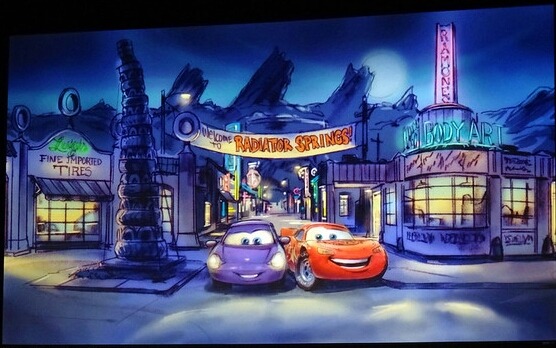
Radiator Springs Racers saved an entire theme park, reversing the fortunes of Disney’s costliest mistake ever. When this high-octance family thrill ride opened in 2012, some said that it stood amongst the best Disney dark rides on Earth – a return to Disney’s dominance and an example of what Imagineering can do. So today, we’ll dig into Disney’s automotive history, from cars to – well – Cars, and see how this larger-than-life E-Ticket at Disney California Adventure set a new standard for the industry.
And before we head off, remember that you can unlock rare concept art and audio streams in this story, access over 100 Extra Features, and recieve an annual Membership card and postcard art set in the mail by supporting this clickbait-free, in-depth, ad-free theme park storytelling site for as little as $2 / month! Become a Park Lore Member to join the story! Until then, let’s start at the beginning…
In the immortal words of Luigi himself, “Now you will have the chance to make this the most glorious race of your lives! Uno for the money; due for the show; tre to get ready and quattro to… go!“
Disney’s cars
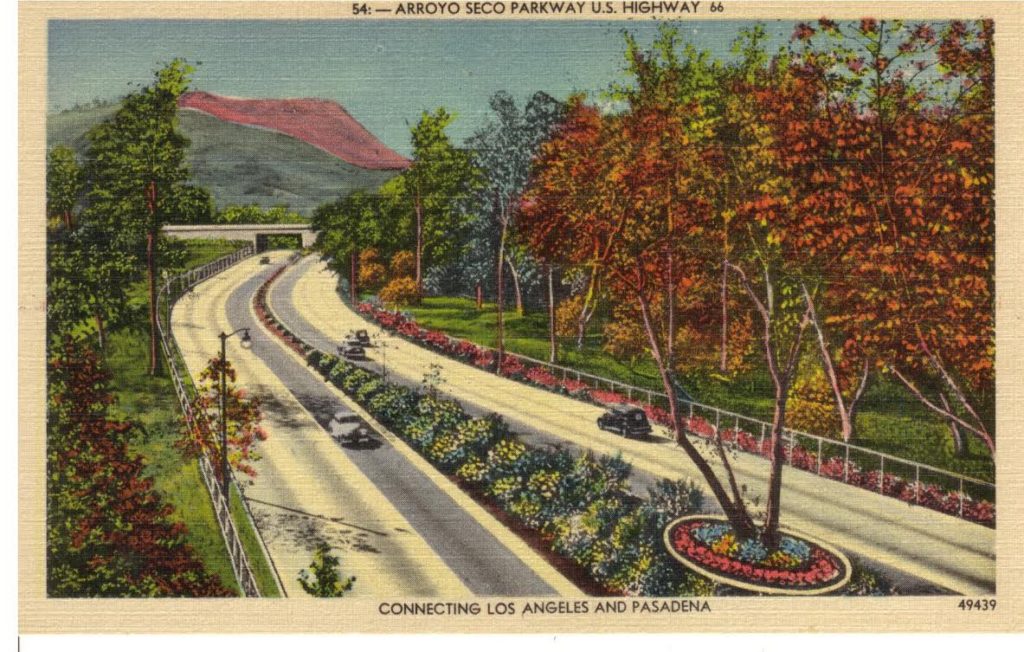
Not coincidentally, the 1940s had shifted American culture forever. Post-World-War-II, the country’s economy was booming. A newly emerging “middle class” had been formed by nuclear families relocating to inexpensive single family homes in suburbs. With two working parents, America’s middle class suddenly found themselves with surplus income and – for the first time in history – free time in which to spend it. It was the birth of car culture.
The reign of the automobile on the West Coast kicked off in the 1940s with the opening of the Arroyo Seco Parkway linking Los Angeles with Pasadena – the first freeway in the Western United States. As it happened, the Arroya Seco Parkway was also a part of the most fabled roadway in the country.
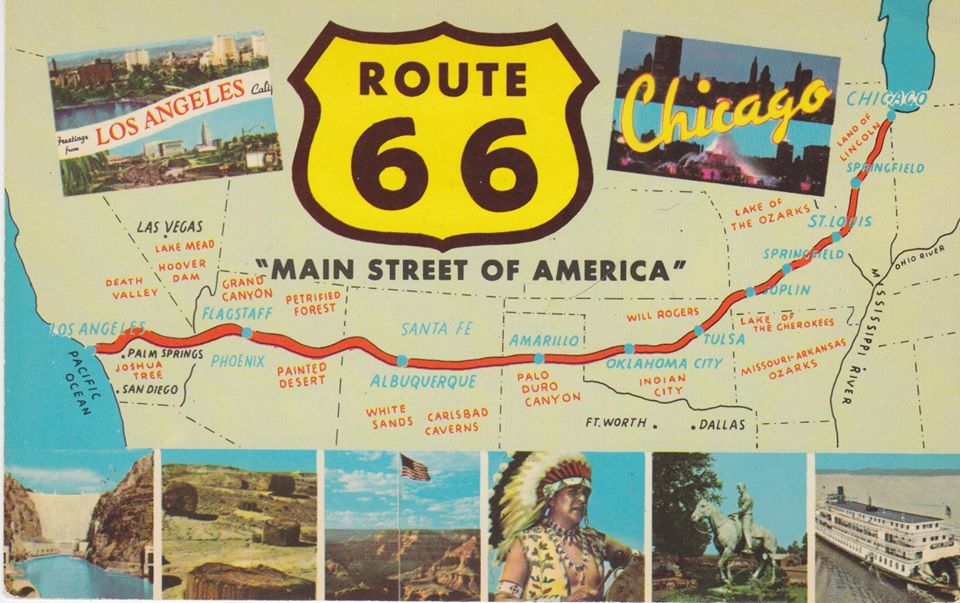
As American families each left car dealerships in their own GM, Ford, and Chrysler cars, Route 66 become the artery of the country; the “Main Street of America.” Connecting Chicago to Los Angeles, the road that had once served as a pathway to prosperity during the Dust Bowl was transformed into a boulevard to the beach, ushering families through towns literally formed off of exit ramps.
Newly mobile, Americans were off to see the sights, with Route 66 passing through the Painted Desert, near the Grand Canyon, and by the Hoover Dam. Along the way, they’d also encounter an entirely new economy of byways and towns springing to life along the road; an era of roadside wonders, must-see tourist traps, and attractions of all kinds.
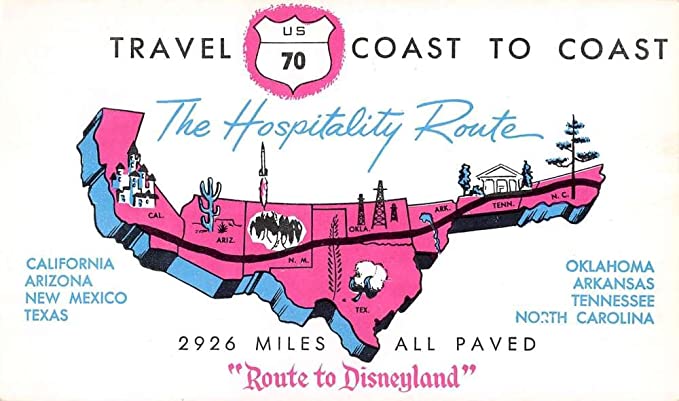
And that included Disneyland. After all, those emerging freeways are what made Walt and his location scouts take notice of the pristine, orange-grove covered town of Anaheim thirty miles outside of Los Angeles, accessible not only by Route 66, but by Route 70 and a growing list of cross-country freeways.
Put simply, cars were a major part of American society by time Disneyland opened, and it was clear that they’d remain an icon of American ingenuity and innovation, deserving a place in “a world of wondrous ideas, signifying Man’s achievement.”
On the move
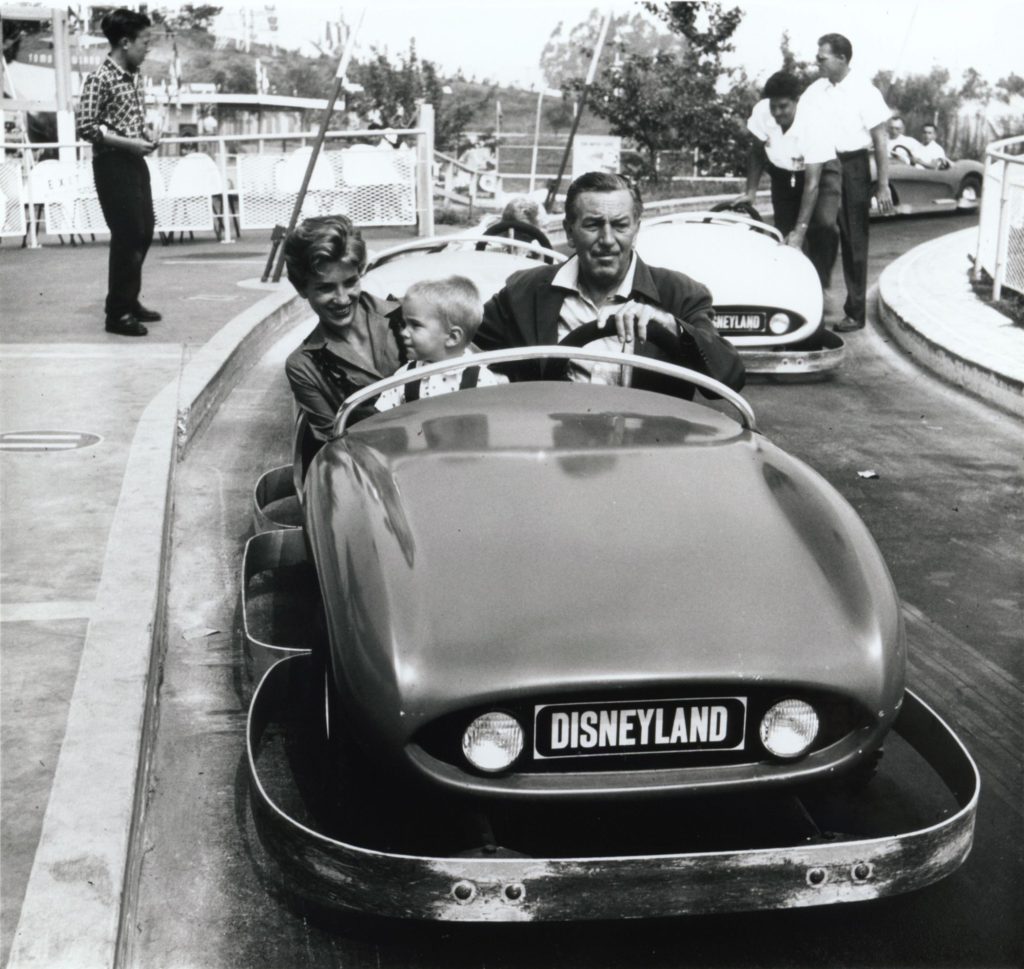
If you want to understand how important cars were to Disneyland, you need only look at the share of the park’s real estate they filled. Out of Walt’s initial land purchase of about 160 acres, 100 were entirely dedicated to cars. Yep, the parking lot! But even inside Disneyland, a further four acres were home to the opening day original, the Autopia.
Even though fans today may balk at the gas-guzzling Autopia taking up valuable real estate in the infamously landlocked park’s Tomorrowland, the seemingly simple car ride was a living demonstration of the future when it opened alongside Disneyland on July 17, 1955. At that time, America’s multilane, limited-access highway system was still being designed, and President Eisenhower wouldn’t sign the Federal-Aid Highway Act (establishing interstate highways) until a year after the park’s opening!
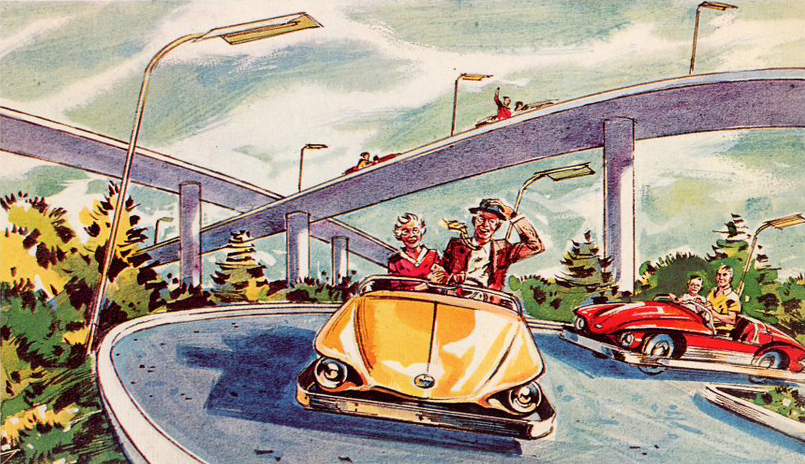
So Autopia was ahead of its time by giving Americans their first experience on elevated highways, curved on-ramps, multi-lane travel, and cloverleaf exits. But more importantly, it become a hallmark attraction of the park – a first real chance for generations of Disneyland guests to get behind the wheel and test out the open road (albeit, not-so-open given that bumpers were added just before the park’s opening and a guide rail was added in 1956 for now-obvious reasons). A product of – and living advertisement for – California’s car culture, Autopia was a hit and required a C-Ticket to ride.
In fact, children of all ages were invited to get behind the wheel in no less than four “Autopias” during Disneyland’s earliest years. The Tomorrowland Autopia opened in 1955, then was joined by Fantasyland’s Junior Autopia in 1956, and the Midget Autopia in 1957 (in this case, referring to the diminutive size of the cars; the ride itself was for those too small to drive the Junior Autopia cars, with no adults allowed!). The grander Fantasyland Autopia then replaced the Junior version in 1959.
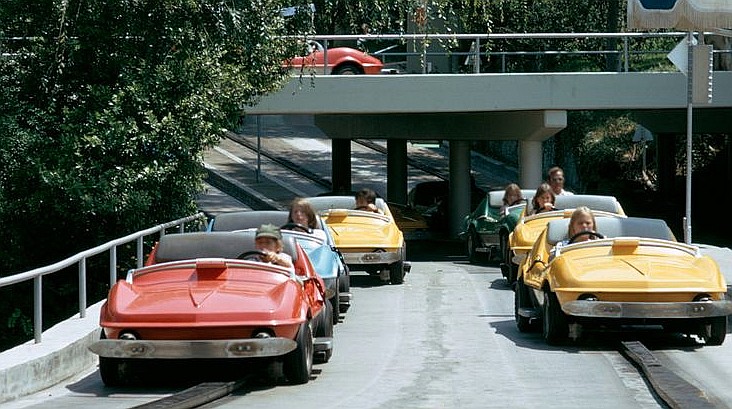
After Eisnerhower’s Interstate Act was signed in 1956, things changed. Slowly but surely, Route 66 and the sideshows, roadside attractions, and towns it had birthed were bypassed by sleek, high-speed, coast-to-coast Interstates. As gas stations and restaurants hurried to relocate to Interstate exits, transportation moved on.
Walt had moved on, too. By the late ’60s, he was concerned with transportation solutions of the future. Disneyland’s 1956 Lost Legend: The Skyway, 1959 Monorail, and 1967 Peoplemover weren’t just rides – they were living prototypes meant to introduce tomorrow’s “world on the move” today.
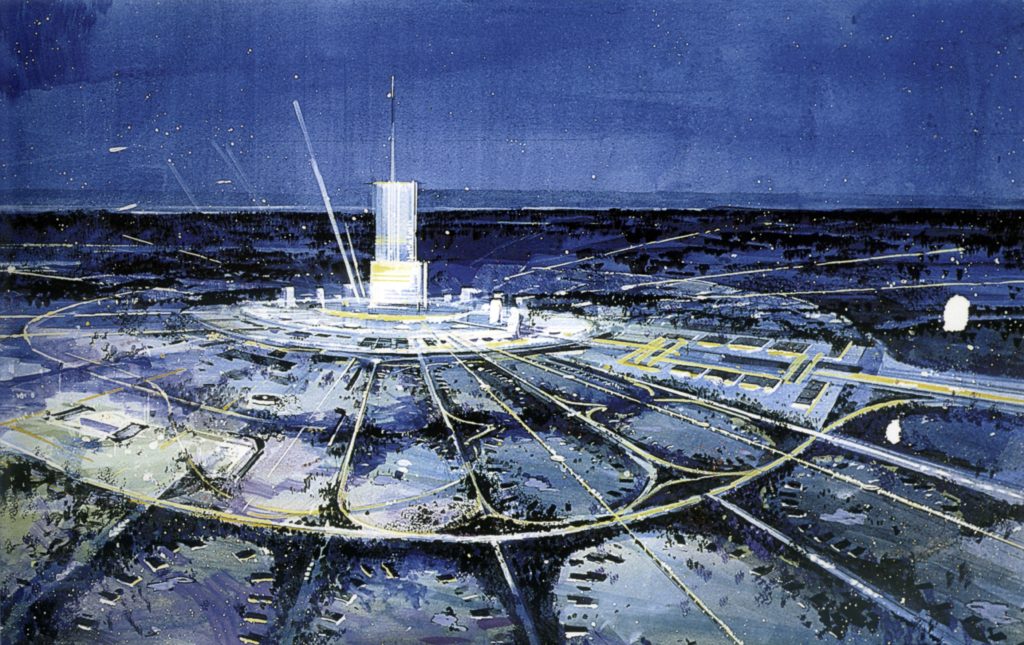
And up until his last days, Walt supposed that the systems acting as attractions at Disneyland would be applied in his new Experimental Prototype Community of Tomorrow. And that brings us to our next car ride…
Future World (of Motion)
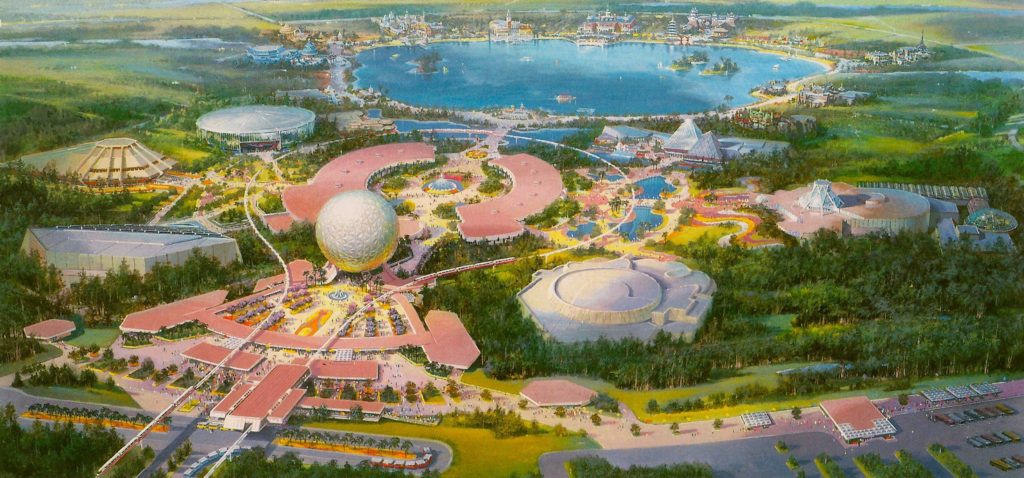
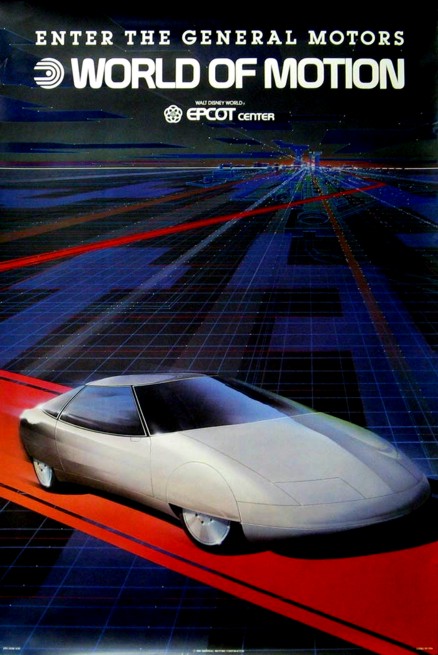
Of course, E.P.C.O.T. was never built. After Walt’s unexpected death in 1966, leadership at Walt Disney Productions knew that they shouldn’t get into the business of building a utopian, post-industrial city without Walt. Instead, the idea died, leaving Walt Disney World to open as “The Vacation Kingdom of the World” leisure resort we know today.
When plans for a second park at the resort finally came to fruition, they took the form of EPCOT Center, a permanent World’s Fair of monumental pavilions dedicated to areas of science and industry. One of the first sponsors to sign on was General Motors, who sponsored the park’s Lost Legend: World of Motion – an epic dark ride carrying guests through the story of transportation from primitive man to the wonders of the cities of tomorrow (including, of course, GM cars).
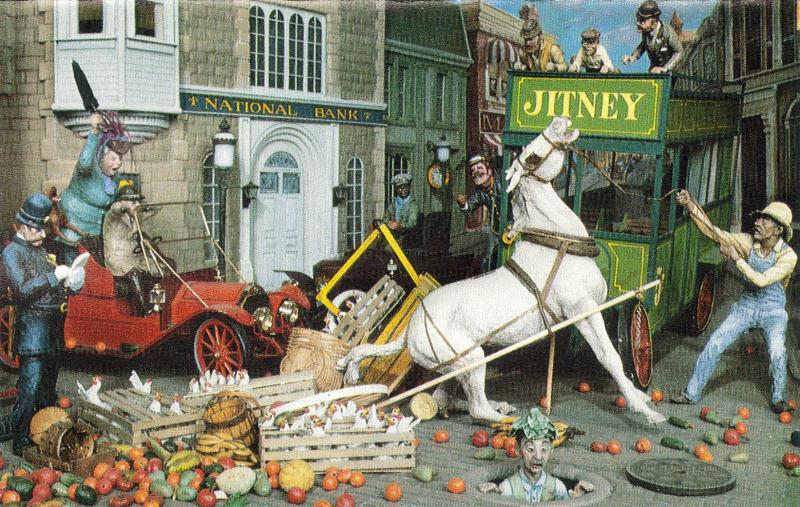
But as the new millennium neared, the renamed Epcot entered a period of change. If you ask many guests, the sincere attempts at futurism based back in the park’s 1982 opening had… well… aged. As sponsors dropped out of the park and Disney sought cheap-and-cheerful answers to its once-educational Epcot, General Motors stepped forward with their own requirement.
Times had been tough for the automaker, and it was becoming increasingly difficult to justify to shareholders and to laid-off employees that GM should continue to sponsor a dark ride through the history of transportation at Walt Disney World. GM offered to renew their sponsorship of Epcot’s transportation pavilion, but only if it would be updated to feature a headlining ride that would highlight – and sell – GM vehicles…
TEST TRACK

Officially opened in March 1999, Epcot’s newest entry looked quite unlike anything the park had done before. While each of its futuristic pavilions had opened with a lengthy, informative dark ride through its highlighted area of industry, the new TEST TRACK was different. Rather than leading guests through a feel-good, sing-song retrospective of Marc Davis-produced Audio Animatronic scenes, the ride was a thrilling tour of a GM safety testing facility aboard a car being put through the paces… with guests in the seat of test dummies.
TEST TRACK was an unusually unskinned dark ride for Disney, hollowing out the former World of Motion showbuilding to create a cavernous, industrial proving ground filled with in-your-face tests sending’s vehicles swerving through cones, rumbling over rugged terrain, accelerating up hairpin inclines, and passing through environmental chambers of hot and cold just like a real test car would endure.
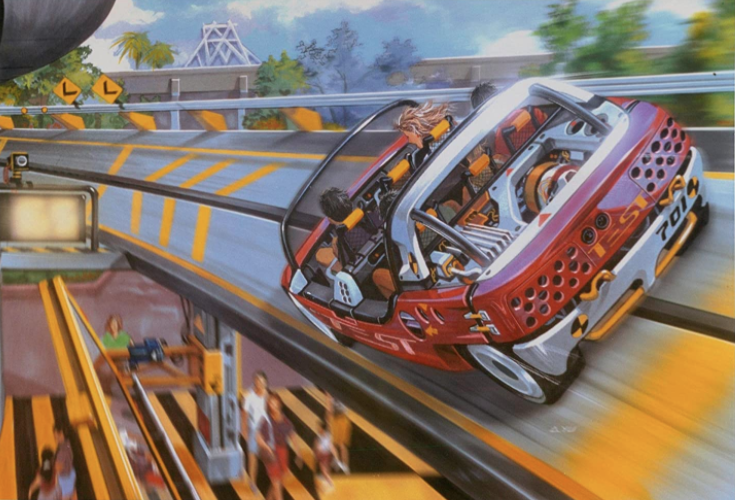
The real innovation of TEST TRACK, though, was in its hardware. Imagine the slot car tracks you might’ve had as a child, where small model cars are affixed to a track using a pin inside of a center guide groove. In these pint-sized slot cars, battery power charges the track, energizing a small motor inside the car through electrical pickups.
On a human-sized scale, TEST TRACK’s six-passenger vehicles would ride along a track with a bus-bar fed down a central slot to guide tires and power supplied beneath. Each of Disney’s vehicles would include three on-board computers to track the ride’s progress and speed, activate show scenes and lightning, and control on-board audio and video cues. But this innovative new ride system really showed off its strength in the ride’s finale, accelerating from 0 – 65 miles per hour – the fastest ride at Walt Disney World.
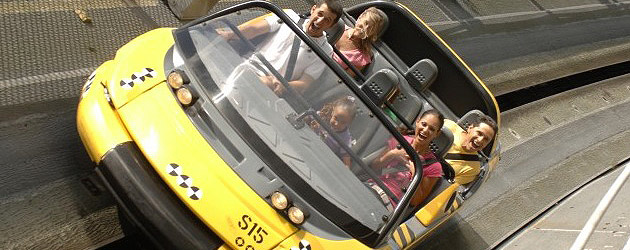
Admittedly, the high-tech hardware turned out to be a little more temperamental than Disney had expected. You can read more about the ride, its original incarnation, and its subsequent 21st century transformation in its own in-depth feature, Lost Legends: TEST TRACK.
At an estimated cost of $100 million – one of the most expensive rides ever developed – Test Track opened on March 17, 1999… almost two years after its scheduled debut. Even still, it was far from the biggest disaster Disney would face at the dawn of the new millennium. Disney’s costliest mistake ever was on the horizon, and it’s there that the promise of celebrating California’s car culture would return on a massive scale… but not in the way you’re expecting…


